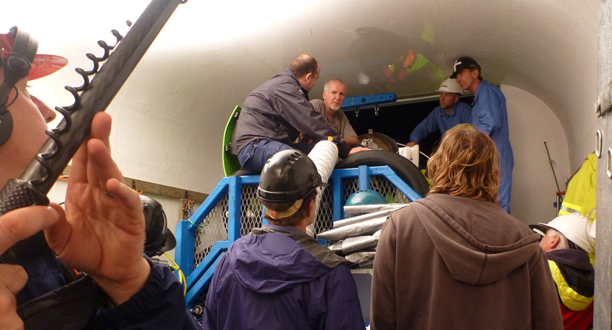The Best of Voyages

On board the Mermaid Sapphire on the Solomon Sea, 100 miles from Rabaul, Papua New Guinea
This is the last day of our 2,000-mile (3,219-kilometer) steam from Sydney, Australia, to Papua New Guinea. We’re five degrees south of the equator and heading northwest at 12 knots across a flat and windless ocean. Tomorrow morning we’ll tie up to the pier in Rabaul and Jim and other members of our team, including National Geographic writer Bruce Barcott and photographer Mark Thiessen will come on board.
At breakfast, “Payload” Dave Mitchell, who works on the landers (and is the ship’s unofficial historian) tells me we’re steaming through the waters where the battle of the Coral Sea was fought. In 1942, the Japanese Navy and American and Australian forces engaged in the first sea battle where both sides neither saw nor fired directly at each other’s ships. The intense two-day conflict was fought by bomb-carrying planes flying off aircraft carriers.
On May 7, Japanese aircraft sank an American destroyer and crippled a fleet oiler; American torpedo bombers sank the Japanese light carrier Shoho. The next day, American pilots damaged the fleet carrier Shokaku, and Japanese pilots struck the carrier Yorktown and critically damaged the carrier Lexington. After suffering heavy losses in aircraft, ships, and men, both two fleets left the area.
The historic battle confirmed that Japanese military expansion could be halted. In addition, two Japanese ships and dozens of aircraft were taken out of the Battle of Midway one month later.
Looking out across the ocean from the Mermaid Sapphire, it’s hard to imagine the ferocity of the fighting 60 years ago. The sea was full of warships and the sky swarmed with dive-bombers. This morning we’re the only vessel in sight and the sky is empty except for high cirrus clouds.
This has been the best of voyages: From the first day, our ship has had fair winds and following seas. We’ve seen majestic sunsets, towering clouds, distant lightning, and the scattered diamonds of the Milky Way. Under Dave Wotherspoon’s direction, the sub team synchronized the 3-D cameras, repaired lights, charged batteries, and finished the new egress skirt. The lander team worked on cameras and the small-boat team made sure their gear was ready for the next dive. Seven days at sea have given Sako’s left forearm time to heal. This morning I took out the 12 stitches and re-bandaged his wound. He’s almost ready for action.
Yesterday, to better understand what the divers and boat crew do during the launch and recovery of the sub, I interviewed Sako, Dave Apperly, and Nic Corkill. They talked about the hazards of attaching the tag lines and wrestling the lift bags into place while the 12-ton sub is moving in the water. They mentioned the muscular effort it takes to hook the crane’s lift line into the sub. Their words filled me with admiration. Rich, Sako, Dave, and Nic perform the most physically demanding tasks of anyone on the team.
Last night I had dinner with the 3-D film crew or, as we affectionately call them, the “Filmies.” They include John Turner, Will Hewetson, Aron Walker, Sam Winzar, and Chris McHattie. Most of them worked together on the recent feature film Sanctum 3D; they are quick with humorous stories and spontaneous laughter.
These long days on the ocean have given all of us—especially the ones on a deep-sea expedition for the first time—a chance to think hard about what we learned during the DEEPSEA CHALLENGER’s first two dives and the tragic helicopter accident that followed. We now understand in a deep visceral way that every dive is a sequence of hundreds of events controlled by thousands of switches, circuits, and mechanisms, any one of which might malfunction. We now know that every dive is a sequence of hundreds of decisions, judgments, and hunches, any one of which might be wrong. These long days with Mother Ocean have allowed us to absorb the great lesson of caution.
Photograph by Joe MacInnis



